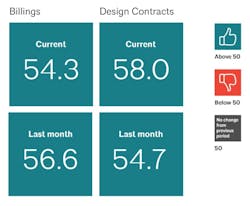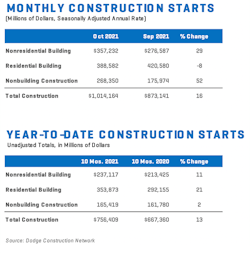October Data: Design Billings Strong, Construction Starts Soar
PRESS RELEASES
WASHINGTON DC, HAMILTON NJ – Nov. 17, 2021 – Architecture firms reported increasing demand for design services in October, according to a new report from The American Institute of Architects (AIA). Meanwhile, total U.S. construction starts pushed 16% higher in October to a seasonally adjusted annual rate of $1.01 trillion, according to Dodge Construction Network. Nonresidential building starts gained 29% and nonbuilding moved 52% higher in October, according to DCN.
“Economic growth has resumed following the third quarter’s Delta-led slowdown. However, the construction sector’s grip on growth remains tenuous,” said DCN Chief Economist Richard Branch.
That may have been evident in AIA's Architecture Billings Index (ABI) score for October, which dipped to 54.3. While down slightly from September’s score of 56.6, it still indicates very strong business conditions overall (any score above 50 indicates an increase in billings from the prior month). During October, scoring for both the new project inquiries and design contracts expanded, posting scores of 62.9 and 58.0 respectively, AIA notes
“Unlike the economy-wide payroll figures, architecture services employment has surpassed its pre-pandemic high,” said AIA Chief Economist, Kermit Baker, Hon. AIA, PhD. “Staffing continues to be a growing concern at architecture firms and may serve to limit their ability to take on new projects.”
Added Branch, “Long term, construction starts should improve, fed by an increase of nonresidential building projects in the planning pipeline and the recent passage of the infrastructure bill. Both will provide meaningful support and growth to construction in the year to come. This expectation, however, must be tempered by the significant challenges facing the industry: high prices, shortages of key materials, and the continued scarcity of skilled labor. While healing from the pandemic continues, there’s still a long road back to full recovery.”
- Earlier this month, DCN delivered an upbeat 2022 Construction Forecast. See details here.
___________________________________________________________________________________________________
About one fifth of architecture firms expect some form of firm merger or acquisition over the next three to five years
Returning to AIA's October report...
Baker said most architecture firms are still seeing billings growth. In addition, inquiries and the value of new design contracts, both indicators of future work at firms, strengthened in October, meaning that clients are continuing both to start conversations about new projects and are signing contracts to begin those projects in the coming months. Although concerns about staffing, inflation, and material prices and availability remain, they have not yet acted as a major deterrent to projects at this time, according to AIA.
By region, firms located in the Northeast experienced a modest decline in billings in October, after also experiencing a slight downturn in September. Conditions at firms located in the Northeast have generally trended weaker than at firms in other regions of the country in recent years, and this month’s findings continue that pattern. On the other hand, conditions strengthened further at firms located in the Midwest and South, while firms located in the West also reported continued growth, but at a slightly slower pace than in September. Firms with an institutional specialization also reported that the pace of billings growth slowed in October, while business conditions strengthened further at design firms with multifamily residential and commercial/industrial specializations.
Growing employment numbers tempered by inflation concerns
In the broader economy, employment continues to recover from the losses sustained in 2020, with 531,000 new nonfarm payroll positions added in October, although overall employment still remains 2.8% below its pre-pandemic peak. Construction employment continued to expand modestly as well, adding 44,000 new positions. Architecture services employment grew by 2,000 new positions in September (the most recent data available) to a total of 199,400 positions, finally surpassing its pre-pandemic peak of 199,200 positions. While employment for industry remains 8.4% below its all-time high prior to the Great Recession, this is the highest employment has been since December 2008, as employment was falling during that downturn.
However, rising inflation continues to trigger concerns, with the Consumer Price Index (CPI) rising by 0.9% from September to October, and by a substantial 6.2% from one year ago. Energy and food prices have continued to increase in recent months, as have gasoline prices, but the prices of consumer goods, particularly vehicles, have seen some of the steepest increases. Wells Fargo predicts that inflation will continue rising over the next several months, and will not begin to slow until the second quarter of 2022.
Firms anticipate revenue growth, mergers
For this month’s special practice questions, we asked responding firms to think about what their firm will look like over the next several years in several ways. Overall, firms anticipate that their revenue will grow by 5.6% from 2020 to 2021, and by 6.7% in 2022. Larger firms expect the greatest increase in revenue in 2021 (6.0% for firms with annual billings of $5 million or more versus 2.3% for firms with annual billings of less than $250,000), as do firms with multifamily residential (8.6%) and commercial/industrial specializations (6.8%), in contrast to firms with an institutional specialization (2.3%). In addition, there are still firms seeing a decline in billings: 8.2% expect a significant decline of 15% or more this year, while 10.8% expect a modest decline of 5% to 14%. For 2022, the largest firms project the highest increase in revenue (9.8%), while firms of all specializations expect about the same level of growth.
Firms were also asked about the likelihood of mergers and acquisitions at their firm over the next three to five years. Overall, a slightly larger share of firms expects that their firm will acquire another firm, as opposed to merging with or being acquired by another firm (18% versus 16%), with large firms with annual billings of $5 million or more being most likely to expect that they will acquire another firm (37%). On the other hand, firms with annual billings of $250,000 to $5 million were the most likely to anticipate being acquired by, or merging with, another firm (20%).
Finally, firms were asked about the share of leadership at their firm that is expected to retire/significantly scale back involvement in the firm over the next three to five years, an ongoing concern as the baby boomers continue to age. Responding firms indicated that overall, they expect nearly one fifth (19%) of their firm’s leadership to retire in the next three to five years, with small firms reporting that they expect 28% of firm leaders to retire. However, nearly one third of firms (31%) indicated that they do not expect any leaders to step back during that time period, while on the other hand, 17% indicated that they expect at least half of leadership to retire within the next five years, according to AIA.
This month, Work-on-the-Boards participants are telling AIA:
- “Rising construction costs are impacting project timing and execution. Projects that were “done deals” have gone into hold patterns waiting to see if supply chain and labor shortages improve overall development costs.”—17-person firm in the Midwest, institutional specialization;
- “Hospitality industry resilient; projects increasing in general, plus more tourism and a pent up demand for entertainment.”—16-person firm in the West, commercial/industrial specialization;
- “Booming, but winter will tell. Many architectural positions sit unfilled and hurting the firm’s performance.”—2-person firm in the Northeast, mixed specialization;
- “Some of the hottest construction markets in the country. Our civil, structural, and MEP engineers are backlogged 3+ months.”— 9-person firm in the South, commercial/industrial specialization.
#########
For more AIA economic data, click here.

